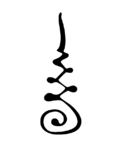Top Qs
Timeline
Chat
Perspective
Urna
Spiral or circular dot placed on the forehead of Buddhist images From Wikipedia, the free encyclopedia
Remove ads
In Buddhist art and culture, the Urna (ūrṇā, ūrṇākeśa or ūrṇākośa[1][2] (Pāli uṇṇa), and known as 白毫; báiháo in Chinese) is a spiral or circular dot placed on the forehead of Buddhist images as an auspicious mark.[2][3]
As set out in the Lakkhana Sutta or 'Discourse on Marks', the ūrṇā is the thirty-first physical characteristic of Buddha.[4] It is generally thought to be a whorl of hair and be a mark or sign of the Buddha as a mahāpuruṣa or great being.[citation needed] The device is often seen on sculptures from the 2nd century CE.[citation needed]
Remove ads
Gallery
- Buddha with urna depicted as a circular dot
- Buddha sculpture found within the vihāra of Wat Phra Si Sanphet, Phra Nakhon Si Ayutthaya Province, Thailand, 16th century CE
See also
References
Wikiwand - on
Seamless Wikipedia browsing. On steroids.
Remove ads


